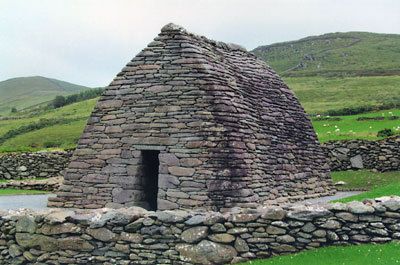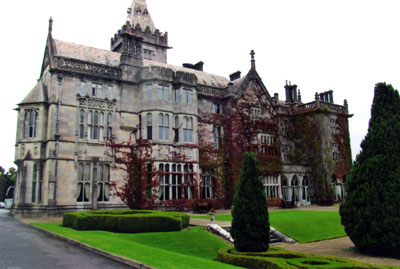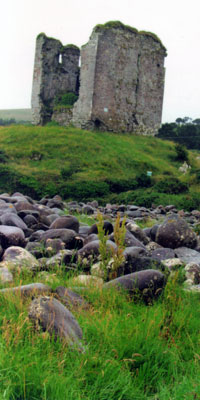Antiquities in our backyard — Dingle Peninsula
This item appears on page 60 of the February 2013 issue.
(1 of 2 on Ireland)
My husband, Paul, and I knew exactly what we wanted on this Irish trip: archaeological sites, scenery, peace and serenity… and (when we were tired of the peace and serenity) pubs with good beer and traditional Irish music.
We found everything we wanted on the Dingle Peninsula, which juts out into the Atlantic Ocean from Ireland’s western coast. The peninsula is one of the Gaeltacht areas, where Irish is spoken and where road signs are often in Irish only, with no English equivalent, leading to serendipitous discoveries.
The Dingle Peninsula is rich in archaeological sites, ranging from the prehistoric, dating back more than 6,000 years, up to the ruins of 19th-century “famine cottages.”
In the two weeks we lived on the Dingle Peninsula in July 2012, we visited dozens of archaeological sites, none of them more than 20 miles from our front doorstep and most within 10 miles. All were delightfully empty of crowds — even in midsummer — and all were easily toured within an hour (“non-labor-intensive archaeology,” Paul calls it).
I’ve selected several archaeological sites from three different time periods as a sampling of what the Dingle Peninsula has to offer.
Prehistoric fort
One of the most dramatic sites we visited was Dunbeg (Dún Beag in Irish), a promontory fort perched on a cliff that descends steeply into the sea. Built possibly as early as the ninth century BC, Dunbeg was occupied on and off over the next 1,800 years. It may have served as a place of refuge in troubled times, as a shelter for a family or as a ritual center — possibly all three during its long history.
Still visible are banks, ditches and a rampart as well as an underground tunnel called a souterrain and small spaces on either side of the entrance that might have been guardrooms, all emphasizing the fort’s past use as a place of defense. Inside the fort, itself, is a large, circular-stone beehive hut, or clochan, once used for shelter.
Early Christian sites
In contrast to this defensive structure are the early Christian sites dotting the peninsula. The most impressive and complete of these is Reask, a settlement consisting of beehive huts, oratory, kiln and cemetery, all enclosed within a stone wall.
Reask was probably built in the late fifth century AD and was inhabited for 700 years. Although it was primarily a monastic site, later in its history it may have been inhabited by a small group of families. There’s a magnificent pillar stone next to the oratory with a Maltese cross inscribed over much earlier Celtic designs.
The jewel of all the Dingle antiquities has got to be the Gallarus Oratory, dating from about AD 700. It is a complete and perfect example of what the Reask Oratory once must have looked like. The small church, built of unmortared stone, looks like a boat turned upside down.
Although it belongs to a much later era, the church at Kilmalkedar (Cillmaolceadair in Irish) should be mentioned. The church, itself, is Romanesque, dating from the 12th century. But in the graveyard in front of the church stands a large, early-Christian cross carved from a single stone, an early sundial and a pillar with ogham inscriptions. Ogham is an early form of writing in which lines are incised into stone along a vertical edge. This pillar is possibly 800 years older than the church, itself.
Inside the ruined church is an early Christian stone inscribed with the Latin alphabet.
Medieval towers
In the 15th and 16th centuries, tower houses were erected all over Ireland. They are often called castles, but they are actually sturdily built stone towers that were meant to serve as both residence and fortress for local nobility.
Paul and I visited two on the Dingle Peninsula: Minard Castle, whose exterior is more or less intact, and Rahinnane Castle, in a much more ruinous condition but whose deep ditch can still be seen (and walked in) and whose interior is clearly visible and can be explored, albeit with caution. Both castles were bombarded and destroyed in the mid-17th-century Cromwellian wars.
These are but the tip of the archaeological iceberg on Dingle but are among the best to visit, especially if one has only a few days. All these antiquities were practically in our backyard in terms of distance, but we had one antiquity literally in our front yard.
Just a dozen steps from the front door of our rental house was a stone beehive hut in near-perfect condition. We even had a few tourists who hiked up our long driveway to photograph it.
Scenery and serenity
We love visiting archaeological sites, but it wasn’t the only reason we chose the Dingle Peninsula. The peninsula is one of the most scenically dramatic parts of Ireland, surrounded as it is by the sea on three sides.
Especially breathtaking (literally, if you drive) is Slea Head, on the western end of the peninsula, where our rental house was located. Meadows fall precipitously into the sea. From our house we could see and hear waves crashing against the jagged rocks and see the Blasket Islands just offshore.
Even in July, with the tourist season in full swing, there was plenty of the peace and quiet we, as New Yorkers, crave when away from home. Our nearest neighbors were the cows on the steep mountainside behind our house, the sheep in the field next to the beehive hut, and Gussie and Herb, the two beautiful horses in the field close to our front door, to whom we fed apples and carrots daily.
Pubs aplenty
When we wanted “action,” we drove into the town of Dingle — a 10-mile drive over a narrow mountain road or on the sometimes hair-raising, winding Slea Head coastal road. Dingle may be a small town in terms of population (2,500), but it is big in terms of pubs offering food, brew, music and craik (lively conversation).
In two weeks we visited more than a dozen pubs, but our favorites were Murphy’s, John Ben Moriarty’s and the Dingle Pub. We loved sampling Irish beers and the traditional Irish music sessions that usually begin each evening in summer at about 9:30 p.m.
If you go…
Our comfortable traditional stone rental house — with living room, dining room, large country kitchen, three bedrooms and one bathroom plus spectacular views in all directions — was located on the Slea Head Drive in Coumeenole, 10 miles west of Dingle town. A 2-week rental in July cost us $2,100.
Best was having a turf fire going almost every evening and the view of the Atlantic from almost every window and from the stone dolmen-looking table outside the front door. We found the house listed with HomeAway (Austin, TX).
Two museums not to miss — Corca Dhuibhne Regional Museum in Ballyferriter and the Celtic & Prehistoric Museum in Ventry. Both are within eight miles of Dingle town.
Someplace special
It’s about a 2½-hour drive from Shannon Airport to the Dingle Peninsula. Rather than drive straight to our rental upon our arrival in Ireland, we decided to treat ourselves to an overnight at the very special Adare Manor (phone 353 61 605200, fax 353 61 396124 or phone, in US & Canada, 800/462-3273) in the village of Adare, about 30 minutes from the airport.
Adare Manor is a lovely, turreted, 19th-century neo-Gothic mansion built by the 2nd Earl of Dunraven and set in manicured gardens beside a river. It is the epitome of genteel elegance, with spacious guest rooms and beautifully decorated public areas, a formal afternoon tea, and dinner fit for a nobleman.
Room rates range from €240 to €900 (about $300-$1,130) per night, this last rate for the Presidential Suite. Check online for packages that include room, dinner and Irish breakfast.
For lovers of archaeology, there are ogham stones on the grounds imported from County Kerry by the 3rd Earl. They are over 1,500 years old and commemorate long-deceased persons.



